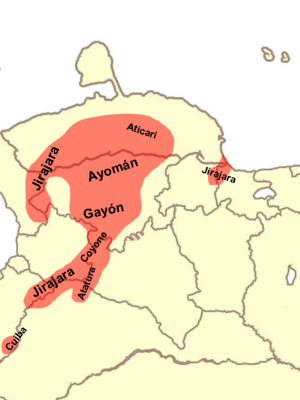Jirajaran languages
| Jirajaran | |
|---|---|
| Hiraháran | |
| Geographic distribution: | Western Venezuela |
| Linguistic classification: | One of the world's primary language families |
| Subdivisions: | |
| Glottolog: | jira1235[1] |
|
Pre-contact distribution of the Jirajaran languages | |
The Jirajaran languages are group of extinct languages once spoken in western Venezuela in the regions of Falcón and Lara. All of the Jirajaran languages appear to have become extinct in the early 20th Century.[2]
Characteristics
Based on the little documentation that exists, a number of typological characteristics are reconstructable:[3]
- 1. VO word order in transitive clauses
- apasi mamán (Jirajara)
- I.cut my.hand
- I cut my hand
- 2. Subjects precede verbs
- depamilia buratá (Ayamán)
- the.family is.good
- The family is good
- 3. Possessors which precede the possessed
- shpashiú yemún (Ayamán)
- arc its.rope
- the arc of the rope
- 4. Adjectives follow the nouns they modify
- pok diú (Jirajara)
- hill big
- big hill
- 5. Numerals precede the nouns they quantify
- boque soó (Ayamán)
- one cigarette
- one cigarette
- 6. Use of postpositions, rather than prepositions
- angüi fru-ye (Jirajara)
- I.go Siquisique-to
- I go to Siquisique.
Classification
The Jirajaran languages are generally regarded as isolates. Adelaar and Muysken note certain lexical similarities with the Timotean languages and typological similarity to the Chibchan languages, but state that the data is too limited to make a definitive classification.[2] Jahn, among others, has suggested a relation between the Jirajaran language and the Betoi languages, mostly on the basis of similar ethnonyms.[4] Greenberg and Ruhlen classify Jirajaran as belonging to the Paezan language family, along with the Betoi languages, the Páez language, the Barbacoan languages and others.[5]
Family Division
Based on adequate documentation, three languages are definitively classified as belonging to the Jirajaran family:[2]
- Jirajara, spoken in the state of Falcón
- Ayomán, spoken in the village of Siquisique in the state of Lara
- Gayón, spoken at the sources of the Tocuyo River in the state of Lara
Loukotka includes four additional languages, for which no linguistic documentation exists:[6]
- Coyone, spoken at the sources of the Portuguesa River in the state of Portuguesa
- Cuiba, spoken near the city of Aricagua
- Atatura, spoken between the Rocono and Tucupido rivers
- Aticari, spoken along the Tocuyo River
Vocabulary Comparison
| English | Ayomán | Gayón | Jirajara |
|---|---|---|---|
| fire | dug | dut, idú | dueg |
| foot | a-sengán | segué | angán |
| hen | degaró | digaró | degaró |
| house | gagap | hiyás | gagap |
| snake | huhí, jují | jují | túb |
| sun | iñ | yivat | yuaú |
References
- ↑ Hammarström, Harald; Forkel, Robert; Haspelmath, Martin; Bank, Sebastian, eds. (2016). "Jirajaran". Glottolog 2.7. Jena: Max Planck Institute for the Science of Human History.
- 1 2 3 Adelaar, Willem F. H.; Pieter C. Muysken (2004). The Languages of the Andes. Cambridge: Cambridge University Press. pp. 129–30. ISBN 0-521-36275-X.
- ↑ Costenla Umaña, Adolfo (May 1991). Las Lenguas del Área Intermedia: Introducción a su Estudio Areal (in Spanish). San José: Editorial de la Universidad de Costa Rica. pp. 56–8. ISBN 9977-67-158-3.
- 1 2 Jahn, Alfredo (1973) [1927]. Los Aborígenes del Occidente de Venezuela (in Spanish). Caracas: Monte Avila Editores, C.A.
- ↑ Greenberg, Joseph; Ruhlen, Merritt (2007-09-04). "An Amerind Etymological Dictionary" (pdf) (12 ed.). Stanford: Dept. of Anthropological Sciences Stanford University. Retrieved 2008-06-27.
- ↑ Loukotka, Čestmír (1968). Classification of South American Indian Languages. Los Angeles: UCLA Latin American Center. pp. 254–5.
